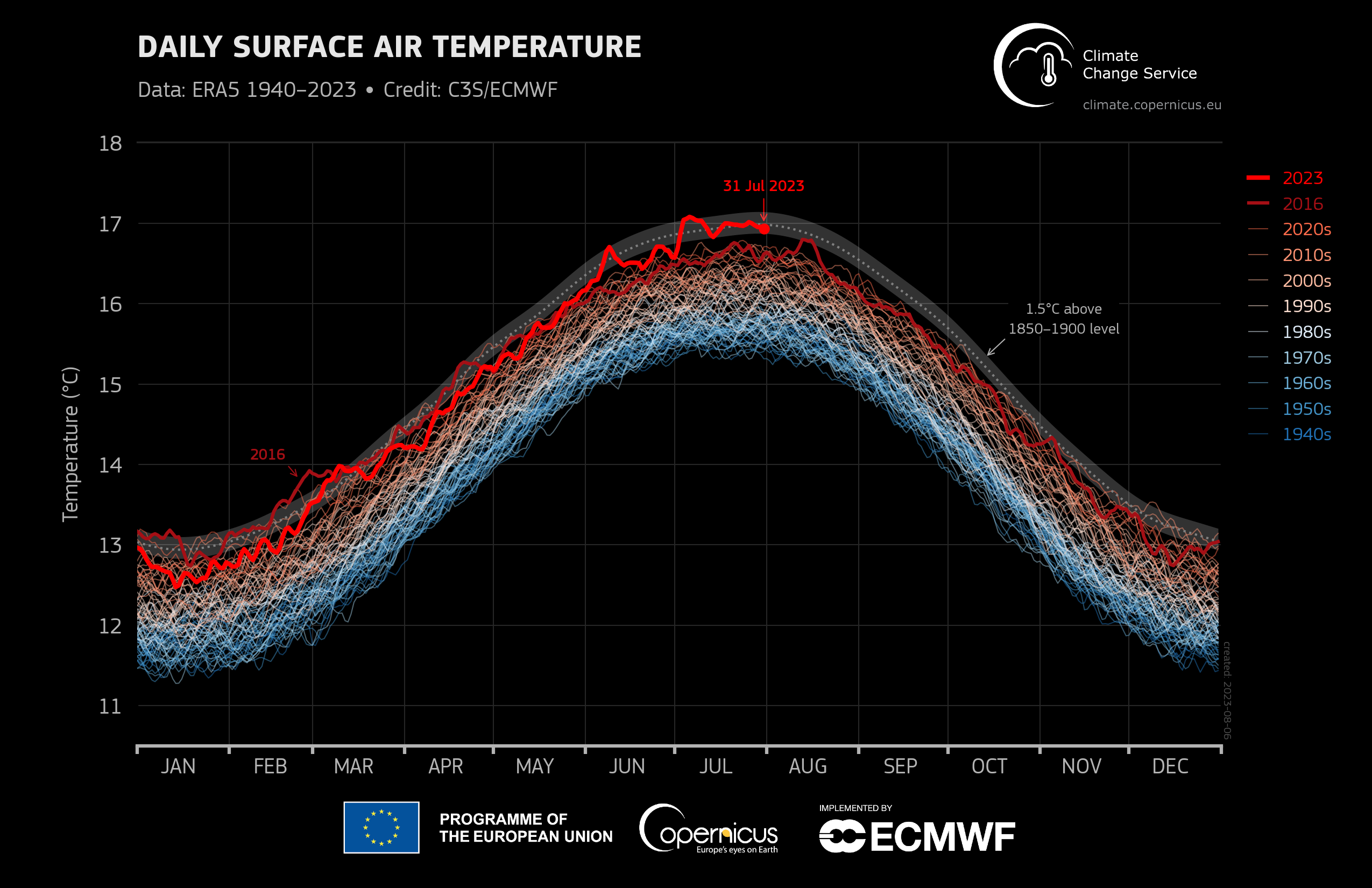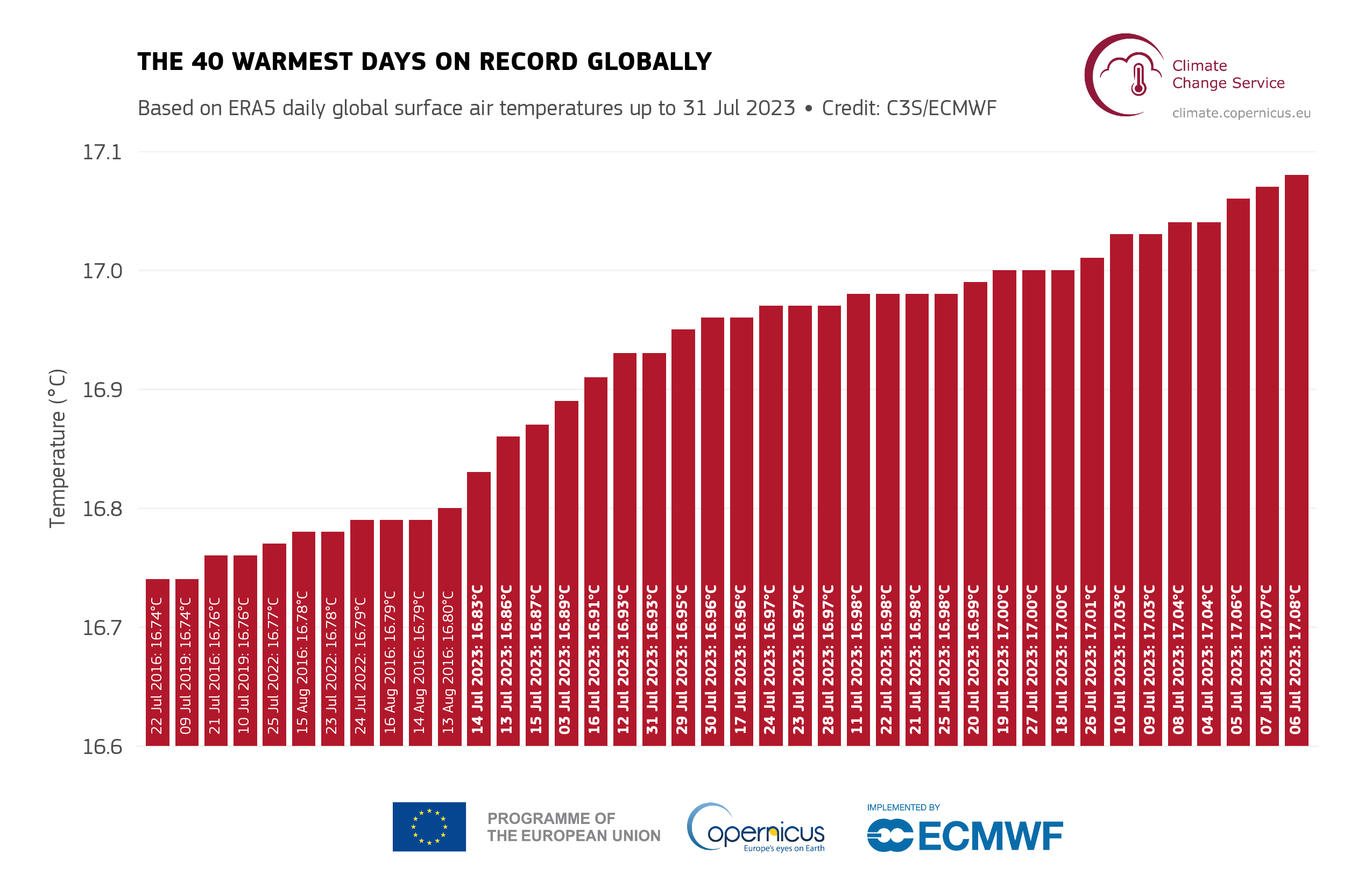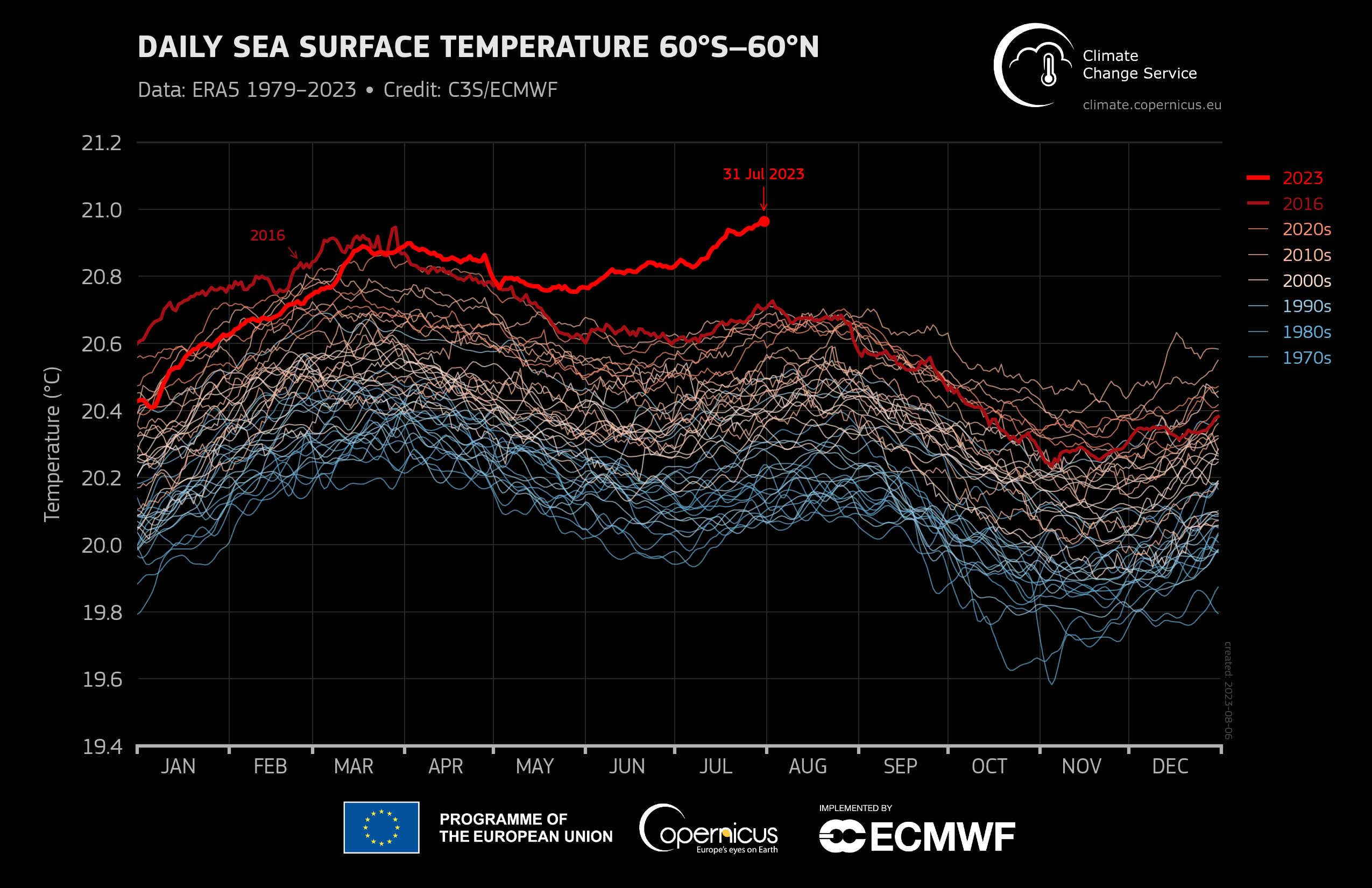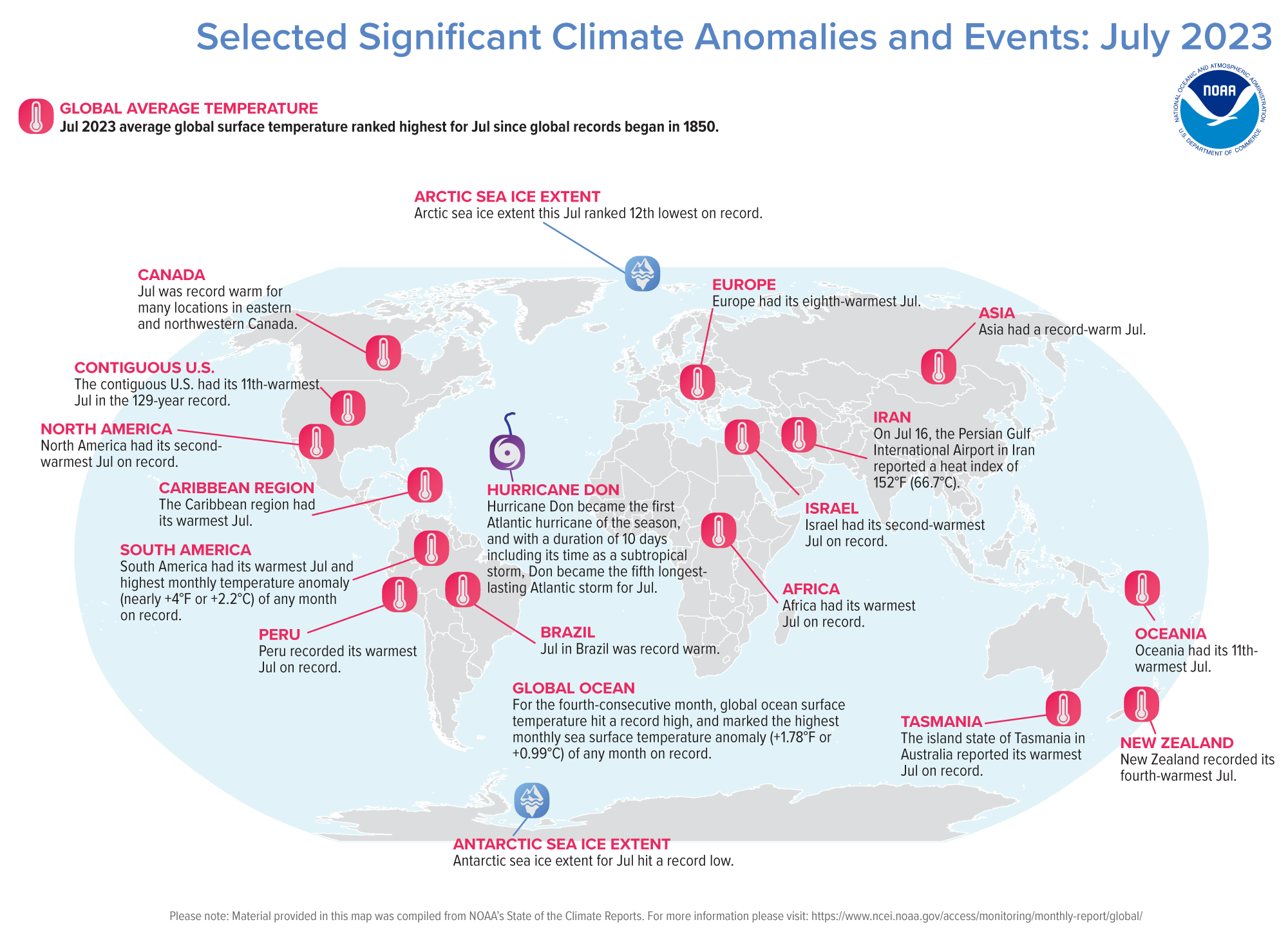July 2023 confirmed hottest month on record globally

Global daily surface air temperature (C) from January 1, 1940, to July 31, 2023, plotted as time series for each year. 2023 and 2016 are shown with thick lines shaded in bright red and dark red, respectively. Other years are shown with thin lines and shaded according to the decade, from blue (1940s) to brick red (2020s). The dotted line and grey envelope represent the 1.5 C threshold above preindustrial level (1850–1900) and its uncertainty. Data: ERA5. COPERNICUS CLIMATE CHANGE SERVICE, ECMWF/Graphic
Aug. 14 (ZFJ) — July 2023 was the hottest month on record globally, confirmed the Copernicus Climate Change Service on Tuesday, Aug. 8.
The monthly average temperature worldwide was 16.95 degrees Celsius (62.51 degrees Fahrenheit), exceeding July 2019’s previous record of 16.63 C (61.93 F) and meeting the Paris Agreement threshold of 1.5 C (2.7 F) warming above preindustrial levels.
The 29 days from July 3-31 were the hottest days on record, exceeding the previous daily global mean surface air temperature record of 16.80 C (62.24 F) from Aug. 13, 2016.
 Ranking of the top 40 warmest days in the ERA5 dataset based on globally averaged surface air temperature. Days in July 2023 are highlighted in bold. Data: ERA5. COPERNICUS CLIMATE CHANGE SERVICE, ECMWF/Graphic
Ranking of the top 40 warmest days in the ERA5 dataset based on globally averaged surface air temperature. Days in July 2023 are highlighted in bold. Data: ERA5. COPERNICUS CLIMATE CHANGE SERVICE, ECMWF/Graphic
The hottest day was July 6 at 17.08 C (62.74 F), while July 5 and 7 were 0.01 C (0.02 F) of it.
The first and third weeks of this July temporarily exceeded the Paris Agreement’s 1.5 C (2.7 F) threshold—the first time this event occurred in July.
“Record-breaking temperatures are part of the trend of drastic increases in global temperatures,” said C3S Director Carlo Buontempo. “July’s record is unlikely to remain isolated this year; C3S’ seasonal forecasts indicate that over land area temperatures are likely to be well above average.”
The confirmation by the C3S, a European Union program under the European Centre for Medium-Range Weather Forecasts, is based on the ERA5 data record, which goes back to 1940.
Surface sea temperatures (SSTs) have been unusually high this year since April. In July, they reached a record high of 20.96 C (69.73 F) on July 31. The previous highest was 20.95 C (69.71 F) on March 29, 2016.
The global average SST was 0.51 C (0.92 F) above the 1991-2020 average.
 Daily global sea surface temperature (C) averaged over the 60 S–60 N domain plotted as a time series for each year from January 1, 1979, to July 31, 2023. The years 2023 and 2016 are shown with thick lines shaded in bright red and dark red, respectively. Other years are shown with thin lines and shaded according to the decade, from blue (1970s) to brick red (2020s). Data: ERA5. COPERNICUS CLIMATE CHANGE SERVICE, ECMWF/Graphic
Daily global sea surface temperature (C) averaged over the 60 S–60 N domain plotted as a time series for each year from January 1, 1979, to July 31, 2023. The years 2023 and 2016 are shown with thick lines shaded in bright red and dark red, respectively. Other years are shown with thin lines and shaded according to the decade, from blue (1970s) to brick red (2020s). Data: ERA5. COPERNICUS CLIMATE CHANGE SERVICE, ECMWF/Graphic
Antarctic sea ice extent was 15% below average, the lowest July extent since satellite observations began, said the World Meteorological Organization, the U.N. weather agency. The WMO noted that Arctic sea ice extent was slightly below average.
“News of the warmest month on record perhaps shouldn’t come as a surprise,” said Christ Hewitt, WMO director of climate services. “As we continue to see increases in concentrations of greenhouse gases in the atmosphere, this long-term warming will continue and temperature records will continue to be broken.”
The China Meteorological Administration reported a new national temperature record of 52.2 C (126.0 F) on July 16 in Turpan, Xinjiang.
Asia, Africa, and South America experienced their hottest July on record.
Continental Europe did not break its record of 48.8 C (119.8 F) in Sicily from Aug. 11, 2021, according to provisional data. It experienced intense heat waves and wildfires in its eighth-warmest July.
North America had its second-warmest July on record. Oceania had its 11-warmest July.
 A map of the world plotted with some of the most significant climate events that occurred during July 2023. NATIONAL CENTERS FOR ENVIRONMENTAL INFORMATION, NOAA/Graphic
A map of the world plotted with some of the most significant climate events that occurred during July 2023. NATIONAL CENTERS FOR ENVIRONMENTAL INFORMATION, NOAA/Graphic
The average temperature across the contiguous U.S. was 75.7 F (24.3 C), making it the 11th-hottest July in the 129-year climate record, said the National Oceanic and Atmospheric Administration.
NOAA reported that Arizona, Florida, Maine, and New Mexico had their warmest July, while it was in the top 10 warmest for 13 additional states.
The U.S. Southwest experienced scorching heat waves, with 36 counties experiencing their hottest July and top 10 warmest in 63 extra counties.
Phoenix, Arizona, had an average temperature of 102.8 F (39.3 C), which is the hottest month for any U.S. city. It also had 31 consecutive days above 110 F (43.3) from June 30 to July 30, breaking the previous record of 18 days from 1974.
California’s Death Valley, the hottest place on Earth, set records on July 16 for daily temperature at 128 F (53.3 C) and on July 17 for midnight temperature at 120 F (48.9 C).
Record warm sea surface temperatures were reported along the southern Florida coast, harming marine life and tourists’ beach plans.
Heat is the leading weather-related killer in the U.S., according to the Environmental Protection Agency.
References
- Copernicus Climate Change Service, European Centre for Medium-Range Weather Forecasts - July 2023 sees multiple global temperature records broken - https://climate.copernicus.eu/july-2023-sees-multiple-global-temperature-records-broken (ARCHIVE)
- World Meteorological Organization - Copernicus confirms July 2023 was the hottest month ever recorded - https://public.wmo.int/en/media/news/copernicus-confirms-july-2023-was-hottest-month-ever-recorded (ARCHIVE)
- U.S. National Oceanic and Atmospheric Administration - July 2023 brought record-high temperatures, devastating floods across the U.S. - https://www.noaa.gov/stories/july-2023-brought-record-high-temperatures-devastating-floods-across-us (ARCHIVE)
- U.S. National Oceanic and Atmospheric Administration - Record shattering: Earth had its hottest July in 174 years - https://www.noaa.gov/news/record-shattering-earth-had-its-hottest-july-in-174-years (ARCHIVE)
